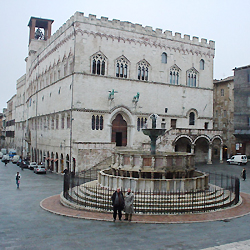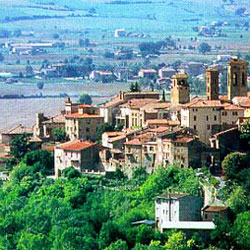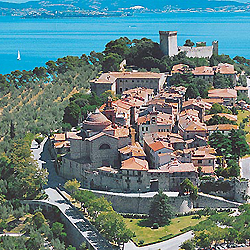Umbria and Marche Tours
Perugia, Deruta, Castiglione del lago | Spoleto, Spello, Bevagna, Assisi | Todi, Orvieto, Civita di Bagnoregio | Gubbio, Urbino
Perugia, Deruta, Castiglione del lago
Suggested day tour from Rome with the visit of Perugia, Deruta and Castiglione del Lago, the service is driver/guided and is individually personalized.
Perugia, Deruta, Castiglione del lago | Spoleto, Spello, Bevagna, Assisi | Todi, Orvieto, Civita di Bagnoregio | Gubbio, Urbino
Perugia, Deruta, Castiglione del lago
Suggested day tour from Rome with the visit of Perugia, Deruta and Castiglione del Lago, the service is driver/guided and is individually personalized.
| Perugia In the heart of Umbria, one finds Perugia, a city born more than two thousand years ago, older even than Rome, still conserved within the city walls built by the Etruscans. It is here that one finds one of Italy's most important archaeological museums the Museo Archeologico Nazionale dell' Umbria, and one of the most important squares in the whole of Italy, Piazza Grande. Visitors to Perugia still enter the city via one of the seven gateways, two of which have the status of monuments: Porta d'Augusto and Porta San Pietro. A city full of historic sites: the Palazzo dell'Università Vecchia, Palazzo del Capitano del Popolo, Palazzo dei Priori, the Cathedral, the Fontana Maggiore, the St Francis Complex, the Oratorio of St Bernardino. Not to be missed is the fortress which encircles the oldest part of the city, a medieval Pompei, brought to light thanks to a series of excavations. The events held in Perugia are of International importance, such as Eurochocolate, event dedicated to chocolate with 9 days of open air tastings, and Umbria Jazz, one of the most famous Jazz festivals in the whole of Europe. |
 |
| Deruta Deruta is known throughout the world for the production of precious majolica and ceramics, the decoration of which dates back to the Medieval ages, during the domination of the church. Even in those days ceramics were exported, guaranteeing Deruta a notable income. It was thanks to the decorations inspired by Raffaello that the product became increasingly famous. Its still possible to admire the majolica in the Ceramic Museum of Palazzetto Municipale, or as architectural ornamentation on the facades of the Church of Madonna delle Piagge. But Deruta is not only about ceramics: characterized by its castle like construction, the city retains, like many of Umbrian towns, its medieval identity with the Porta San Michele Archanegelo, the Palazzotto Municipale, the Church of St Francis, the Church of St Antonio, the Church of the Madonna del Divino Amore. The Artistic heritage of Deruta is abundant, with a series of paintings by from artists such as Alunno, Amorosi, Baciccio, Stendardo, Fiorenzo di Lorenzo and Guido Reno. |
 |
| Castiglione del lago Originally it was an island. Then the waters of Lake Trasimeno receded and Castiglione del Lago was transformed in promontory with panoramic view of the lake. The Castello del Leone, with its irregular pentagonal shape, four corner towers, and 30-meter high triangular "mastio" tower, dominates the lake and the whole of the surrounding area. It was Frederick II of Swabia who ordered the castle's construction in 1247, as part of his extensive defence system which from Puglia spread across the whole of the Italian peninsular. A walkway links the fortress to the 16th century Palazzo della Corgna, designed by the architect Galeazzo Alessi so as to incorporate the pre-existing Palazzetto Baglioni. Inside the Palazzo one of the most important cycles of late Umbrian-Tuscan mannerist artworks can be seen. The Church of Santa Maria Maddalena was built in 1836 on a Greek cross plan. The interiors of the church are embellished with stuccoes by Piervittori. The Baroque Church of S.Domenico di Guzman features a splendid coffered ceiling and numerous artworks dating back to the 17th century. From Castiglione, boats depart for the three islands of Lake Trasimeno: the Isola Maggiore, Isola Minore and Isola Polvese. |
 |